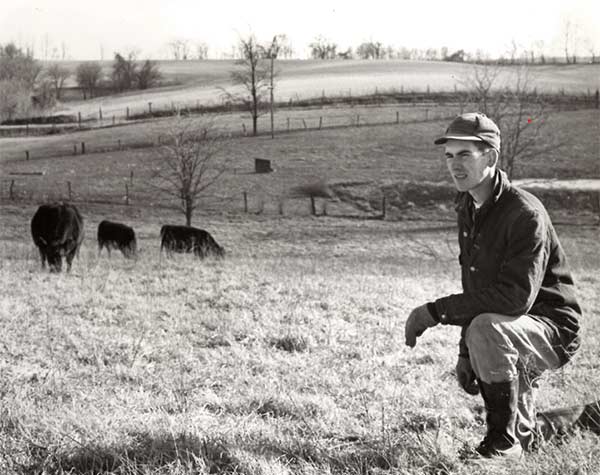Our History
Our family has been in agriculture for 5 generations and Angus cattle have been at the center. The Angus cow has always set the standard for efficiency in the cattle industry and was an integral part of their commercial herd. So, in 1952 Charles and Jere Cannon decided to pursue their dream and bought 3 registered Angus heifers, joining the American Angus Association as Cannon Brothers in 1952, later changing to Stone Gate Farms.
Their first major bull purchase was H H Executive 11 from Hidden Hills Farm of Maryland in 1961. He weighed 1120 pounds at a year, which was a significant feat in that day. He sired a lot of high performing, sale topping cattle throughout Ohio, West Virginia and Kentucky. The University of Kentucky believed in him also and purchased a half interest.
The first cows that made a significant impact on our program were purchased from Monocacy Farm, who happened to be a neighbor to Hidden Hills. Monocacy Farms were, by chance, selling their entire herd privately and 15 head were selected by the Cannon Brothers. These cows would easily work in our herd today as they became the prototype for the Stone Gate cow. Our Eurotia and Joy Erica cow families stem from that herd and now make up almost half of our cow herd today. Another significant influence on our early genetics were cows purchased from Ken Clarke’s Craigie herd in West Virginia. These cows were efficient and displayed the maternal traits that the Angus cow is known for. Mr. Clarke was a great teacher and influenced our breeding philosophy, stressing fertility, longevity, good udders and mothering ability as essential traits to profitable cattle. Another well known herd today has the influence of the Craigie herd, The Connealy Ranch in Nebraska.
Through the early years of trial and error it became clear that the more data they collected, the more consistent their cattle became. In 1957 they enrolled in a new performance program with the University of Kentucky, then in 1967 they enrolled in the AHIR program with the Angus Association. In-herd performance evaluation became a necessary tool in their genetic selection and is still important today, even with EPD’s. As a result, selection for fertility and longevity came to the forefront as the best indicator of profitability. Cows that were able to raise a big calf on their own without creep feeding and breed back on a regular basis became the standard. Being able to identify those individuals who perform optimally year after year gives you a solid foundation to build a herd on.
Charles was an influential member of the American Angus Board of Directors in the 70’s and 80’s, also serving a term as President. Charles was among a group of visionary members who launched the Certified Angus Beef program. Nearly 50 years later, Certified Angus Beef brand has more than exceeded what they envisioned at conception.
In 2023, Chris and Caleb, son and grandson of Charles, took the reins of the Stone Gate Farms operation and have dedicated themselves to continuing the real-world approach to developing superior genetics. Chris is a lifelong cattleman, running both registered and commercial cow calf operations. He has made his interest his profession and has gathered a wealth of knowledge with nearly 45 years in the business. Caleb returned to the farm after 10 years in the Mechanical Engineering profession, seeking to make his part time interest a full-time career. Together, they aspire to bring together the years of knowledge garnered by Charles and Jere with the latest technology and data collection tools available to produce seed stock that thrive in today’s market.




